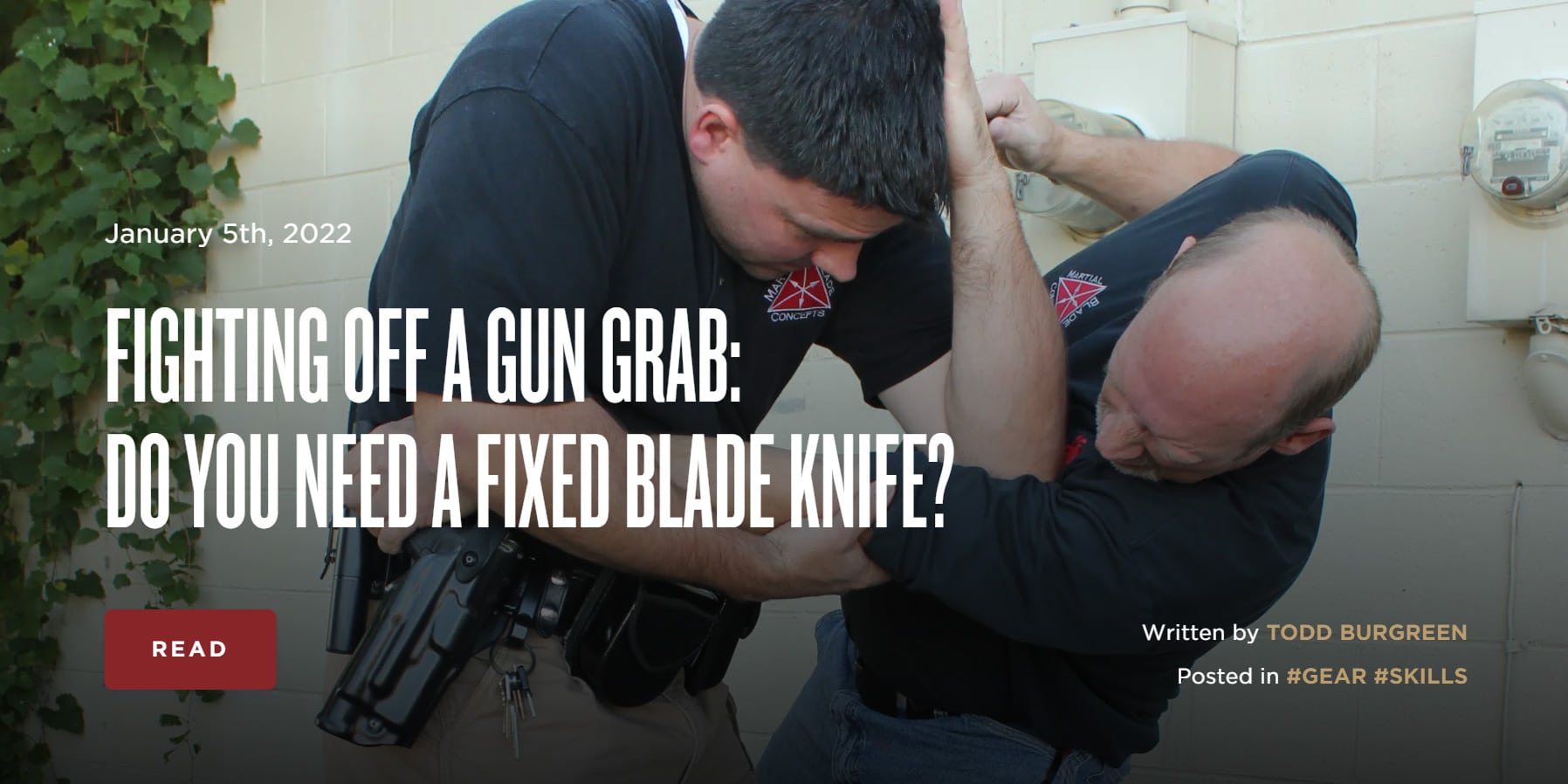Hello all, here is today's article posted on TheArmoryLife.com. It is titled "Fighting Off a Gun Grab: Do You Need a Fixed Blade Knife?" and can be found at https://www.thearmorylife.com/fighting-off-a-gun-grab-do-you-need-a-fixed-blade-knife/.



Great little knife!I carry a KBar TDI for this very reason.
Just looked at that knife online. Going to order one.Great little knife!
I've carried one for about 10 years now.
They feel great in the hand and the blade is really short. It's more of a cutting/slicing blade. The shorter blade has less of a chance of getting snagged on clothing and less chance of getting torqued out of your hand like a fulcrum if pushed from the side where a long blade can be moved a lot easier in a struggle.Just looked at that knife online. Going to order one.
Unless the other guy has a knife too. Then no matter who wins, you both lose. The only way to win a knife fight is to not get into one.A fixed blade is a great back up weapon and probably one of the best weapons you can have in a close contact struggle.
Being proficient with a blade is a whole different skill set, not a smart idea for the untrained.
Todd Burgreen's article said:Thinking equipment alone without training will suffice, however, is more ill-placed optimism. Just like firearms, edged weapons require ongoing training to be effective when you need it most — if not even more.
...no matter the amount training it's not wise to willingly go into a fight with blades even against the unskilled as you will most likely be cut or stabbed. Knife fighting is not like the movies and people don't drop instantly and they can remain a threat long after they receive a fatal blow.
... no matter who wins, you both lose. The only way to win a knife fight is to not get into one.
Yeah, not a bad idea to learn how to use a knife, but trust me, you can have all the high dollar training you want and when the guy you're fighting has a knife as well, you're most likely getting cut up. I've been told by more than one guy with much more experience with actual hand to hand combat that anyone who says they can train you to win knife fights is just stealing your money. Sure, some training can mitigate some situations, but it's just way to impossible to predict movement when a matter of missing by an inch means the big artery on your wrist just got opened up or you now have only one eye ball.^ Which the author did make clear, and is also a sentiment that he highlights again and again throughout the article.
^ And towards this......
-and-
For those who even have a remote chance to engage in good training towards this, the "competitive and non-cooperative" framework for drills as taught by the likes of Craig Douglas/ShivWorks, followed by the crucible of physical combatives, will be eye-opening.
There are now a number of vetted and legitimate schools/trainers offering integrated combatives coursework geared specifically for the legal concealed-carry citizen. It's worth the investment, and yes, they are scaled towards age as well as physical ability/disabilities/injuries. It's not "fight club." It's actual learning, and those who seriously teach it are able to achieve knowledge and skills transfer to even those of us who are not 100% able bodied and/or filled with youthful vigor.
Yeah, not a bad idea to learn how to use a knife, but trust me, you can have all the high dollar training you want and when the guy you're fighting has a knife as well, you're most likely getting cut up. I've been told by more than one guy with much more experience with actual hand to hand combat that anyone who says they can train you to win knife fights is just stealing your money. Sure, some training can mitigate some situations, but it's just way to impossible to predict movement when a matter of missing by an inch means the big artery on your wrist just got opened up or you now have only one eye ball.
In Chicago, legal blade length is limited to 2.5” so the KBar TDI is one of the few legal choices.I carry a KBar TDI for this very reason.
The loser in a knife fight lies bleeding on the ground, the winner lies bleeding in an ambulance.A fixed blade is a great back up weapon and probably one of the best weapons you can have in a close contact struggle.
I've practiced Filipino and Indonesian blade arts for many years and the training will give you a definite advantage but the one thing you learn in the blade arts is that no matter the amount training it's not wise to willingly go into a fight with blades even against the unskilled as you will most likely be cut or stabbed. Knife fighting is not like the movies and people don't drop instantly and they can remain a threat long after they receive a fatal blow.
When I bought mine, I bought the large model to fit my large hands. I recently became aware of the Illinois law (I live on the border of Iowa / Illinois) I will now be purchasing the smaller version.In Chicago, legal blade length is limited to 2.5” so the KBar TDI is one of the few legal choices.
